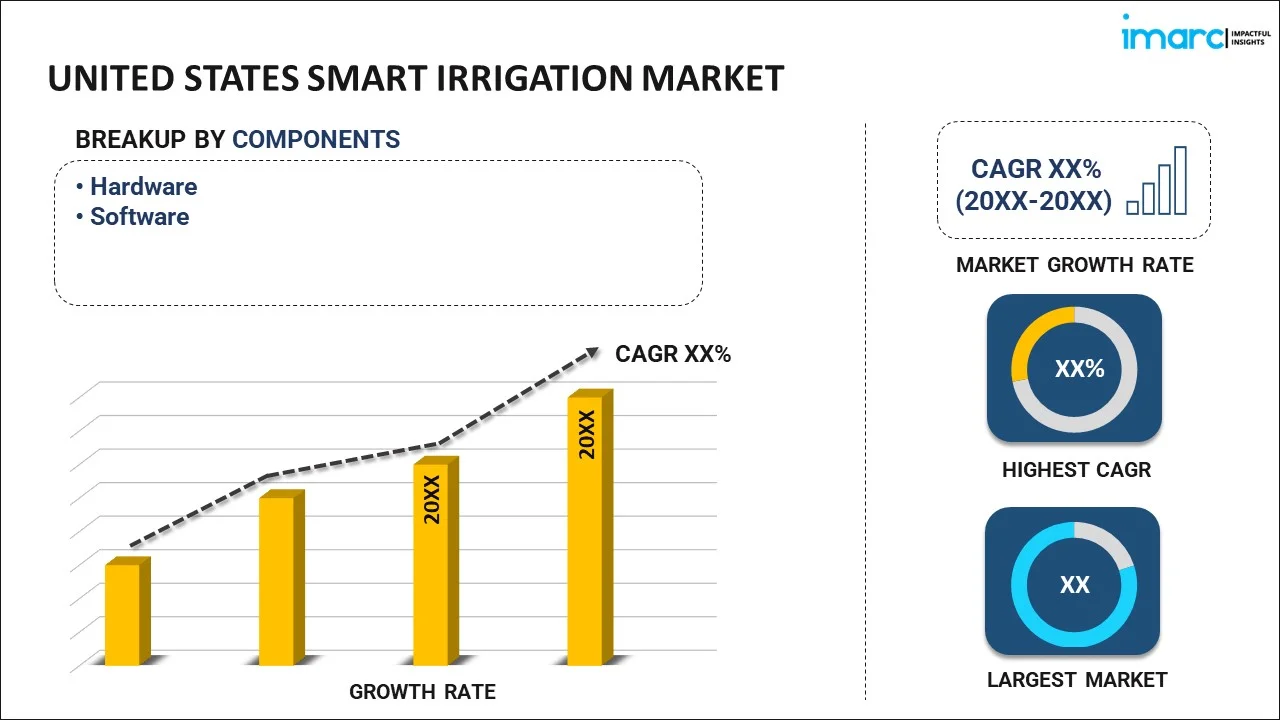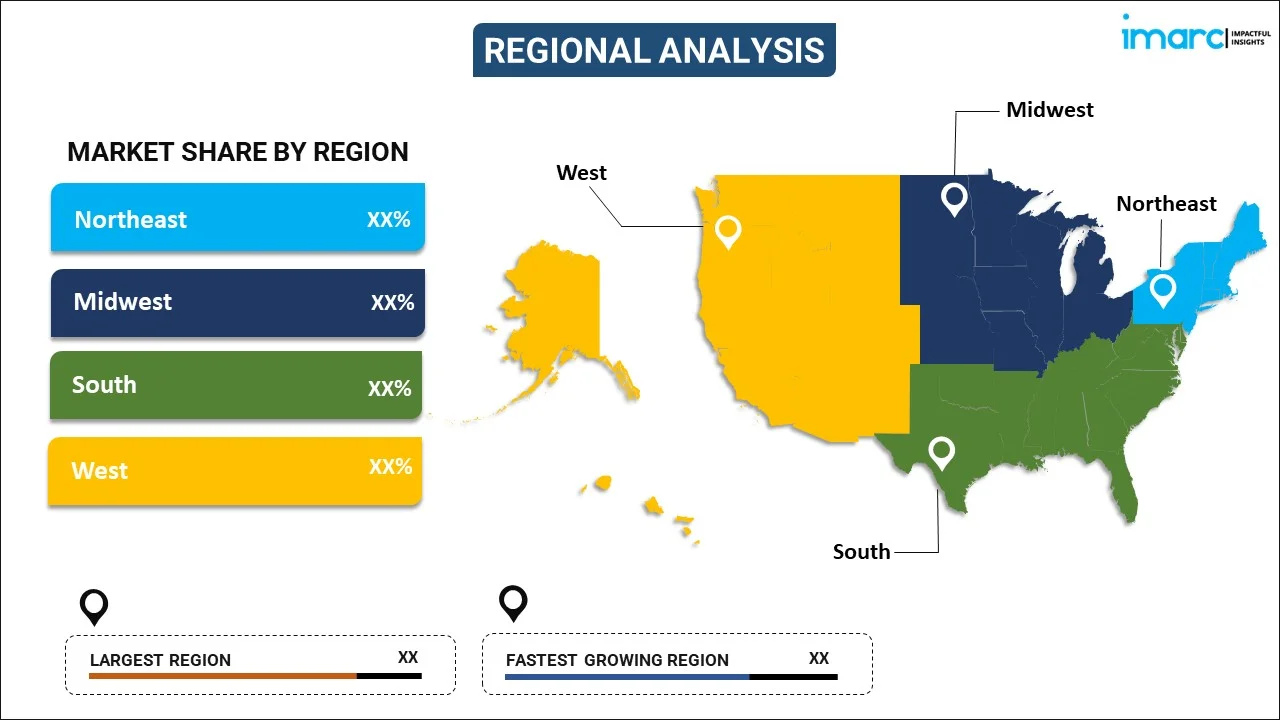
United States Smart Irrigation Market Report by Component (Hardware, Software), Technology (Evapotranspiration, Soil Moisture), Application (Agricultural, Non-Agricultural), System Type (Weather-Based System, Sensor-Based System), and Region 2025-2033
Market Overview:
United States smart irrigation market size is projected to exhibit a growth rate (CAGR) of 14.06% during 2025-2033. The growing concerns about water scarcity, continuous advancements in sensors, cloud computing, and Internet of Things (IoT) connectivity, and the growing trend of sustainable and visually appealing landscapes represent some of the key factors driving the market.
|
Report Attribute
|
Key Statistics
|
|---|---|
|
Base Year
|
2024 |
|
Forecast Years
|
2025-2033 |
|
Historical Years
|
2019-2024
|
| Market Growth Rate (2025-2033) | 14.06% |
Smart irrigation refers to the use of advanced technology and data-driven solutions to optimize the process of watering crops or landscapes. It involves the application of sensors, controllers, and automation to deliver the right amount of water to plants efficiently, considering factors like weather conditions, soil moisture levels, and plant needs. It can automatically adjust watering schedules and flow rates as per the data received from sensors. It minimizes water wastage by only irrigating when necessary, leading to significant water savings. It contributes to conservation efforts and reduces the environmental impact of irrigation. It allows individuals to manage irrigation remotely, making it more convenient and adaptable to changing conditions. It is widely used in agriculture to enhance crop yields and conserve water resources. It is also utilized in residential and commercial landscaping to maintain lush lawns and gardens efficiently. Besides this, it is employed in golf course management to keep fairways and greens in optimal condition. Moreover, as it promotes healthier and more robust plant growth, the demand for smart irrigation is increasing in the United States.
United States Smart Irrigation Market Trends:
The growing concerns about water scarcity in the United States represent one of the primary factors driving the need for smart irrigation systems. Additionally, the increasing emphasis on environmental sustainability is offering a favorable market outlook. Smart irrigation aligns with this trend by reducing water usage and minimizing the environmental impact of irrigation practices. Along with this, continuous advancements in sensors and cloud computing are making smart irrigation systems more affordable, accessible, and user-friendly. These innovations are promoting the adoption of smart irrigation in large agricultural operations to small-scale residential applications. In line with this, governing authorities in the United States are offering incentives and implementing stringent regulations to promote water-efficient practices, including smart irrigation. Tax incentives, rebates, and water-saving mandates are encouraging individuals, farmers, and businesses to invest in smart irrigation systems, thereby propelling the market growth. Apart from this, rapid urbanization in the United States and the growing trend of sustainable and visually appealing landscapes are influencing the market positively. Smart irrigation allows property owners to maintain lush lawns and gardens while conserving water, making it an attractive choice for landscaping professionals and homeowners. Moreover, the integration of the Internet of Things into smart irrigation solutions is stimulating the market growth. IoT-enabled systems can be remotely controlled and monitored via smartphones or computers, offering users convenience and real-time insights into their irrigation operations. Furthermore, several companies in the country are focusing on developing more advanced irrigation solutions that address water conservation, increase crop yields, enhance landscape maintenance, and contribute to sustainable water management practices in various sectors.
United States Smart Irrigation Market Segmentation:
IMARC Group provides an analysis of the key trends in each segment of the market, along with forecasts at the country level for 2025-2033. Our report has categorized the market based on component, technology, application, and system type.
Component Insights:

- Hardware
- Sensors
- Controllers
- Sprinkler Nozzles
- Water Flow Meters
- Others
- Software
The report has provided a detailed breakup and analysis of the market based on the component. This includes hardware (sensors, controllers, sprinkler nozzles, water flow meters, and others) and software.
Technology Insights:
- Evapotranspiration
- Soil Moisture
A detailed breakup and analysis of the market based on the technology have also been provided in the report. This includes evapotranspiration and soil moisture.
Application Insights:
- Agricultural
- Greenhouse
- Open Field
- Non-Agricultural
- Residential
- Turf and Landscape
- Golf Course
- Others
The report has provided a detailed breakup and analysis of the market based on the application. This includes agricultural (greenhouse and open field) and non-agricultural (residential, turf and landscape, golf course, and others).
System Type Insights:
- Weather-Based System
- Sensor-Based System
A detailed breakup and analysis of the market based on the system type have also been provided in the report. This includes weather-based system and sensor-based system.
Regional Insights:

- Northeast
- Midwest
- South
- West
The report has also provided a comprehensive analysis of all the major regional markets, which include Northeast, Midwest, South, and West.
Competitive Landscape:
The market research report has also provided a comprehensive analysis of the competitive landscape. Competitive analysis such as market structure, key player positioning, top winning strategies, competitive dashboard, and company evaluation quadrant has been covered in the report. Also, detailed profiles of all major companies have been provided.
United States Smart Irrigation Market Report Coverage:
| Report Features | Details |
|---|---|
| Base Year of the Analysis | 2024 |
| Historical Period | 2019-2024 |
| Forecast Period | 2025-2033 |
| Units | Million USD |
| Scope of the Report | Exploration of Historical Trends and Market Outlook, Industry Catalysts and Challenges, Segment-Wise Historical and Future Market Assessment:
|
| Components Covered |
|
| Technologies Covered | Evapotranspiration, Soil Moisture |
| Applications Covered |
|
| System Types Covered | Weather-Based System, Sensor-Based System |
| Regions Covered | Northeast, Midwest, South, West |
| Customization Scope | 10% Free Customization |
| Post-Sale Analyst Support | 10-12 Weeks |
| Delivery Format | PDF and Excel through Email (We can also provide the editable version of the report in PPT/Word format on special request) |
Key Questions Answered in This Report:
- How has the United States smart irrigation market performed so far and how will it perform in the coming years?
- What has been the impact of COVID-19 on the United States smart irrigation market?
- What is the breakup of the United States smart irrigation market on the basis of component?
- What is the breakup of the United States smart irrigation market on the basis of technology?
- What is the breakup of the United States smart irrigation market on the basis of application?
- What is the breakup of the United States smart irrigation market on the basis of system type?
- What are the various stages in the value chain of the United States smart irrigation market?
- What are the key driving factors and challenges in the United States smart irrigation?
- What is the structure of the United States smart irrigation market and who are the key players?
- What is the degree of competition in the United States smart irrigation market?
Key Benefits for Stakeholders:
- IMARC’s industry report offers a comprehensive quantitative analysis of various market segments, historical and current market trends, market forecasts, and dynamics of the United States smart irrigation market from 2019-2033.
- The research report provides the latest information on the market drivers, challenges, and opportunities in the United States smart irrigation market.
- Porter's five forces analysis assist stakeholders in assessing the impact of new entrants, competitive rivalry, supplier organization, buyer organization, and the threat of substitution. It helps stakeholders to analyze the level of competition within the United States smart irrigation industry and its attractiveness.
- Competitive landscape allows stakeholders to understand their competitive environment and provides an insight into the current positions of key players in the market.
Need more help?
- Speak to our experienced analysts for insights on the current market scenarios.
- Include additional segments and countries to customize the report as per your requirement.
- Gain an unparalleled competitive advantage in your domain by understanding how to utilize the report and positively impacting your operations and revenue.
- For further assistance, please connect with our analysts.
 Inquire Before Buying
Inquire Before Buying
 Speak to an Analyst
Speak to an Analyst
 Request Brochure
Request Brochure
 Request Customization
Request Customization




.webp)




.webp)












